Items tagged with 'infrastructure'
The plan for a sewer facility in Lincoln Park is set to move forward next year -- with a significant change

The plan for the Beaver Creek Clean River Project -- the sewer facility planned for Albany's Lincoln Park that prompted an upswell of community skepticism this past spring -- has changed, officials announced at a public meeting Tuesday evening at TOAST Elementary.
The project still includes a new sewer facility and park space in the old Beaver Creek ravine, but engineers have made a significant design change that officials say will result in both a smaller footprint and smaller impact.
Here's what's up.
The plan to fix a problem in Albany that's been a century in the making -- and the concerns about that fix
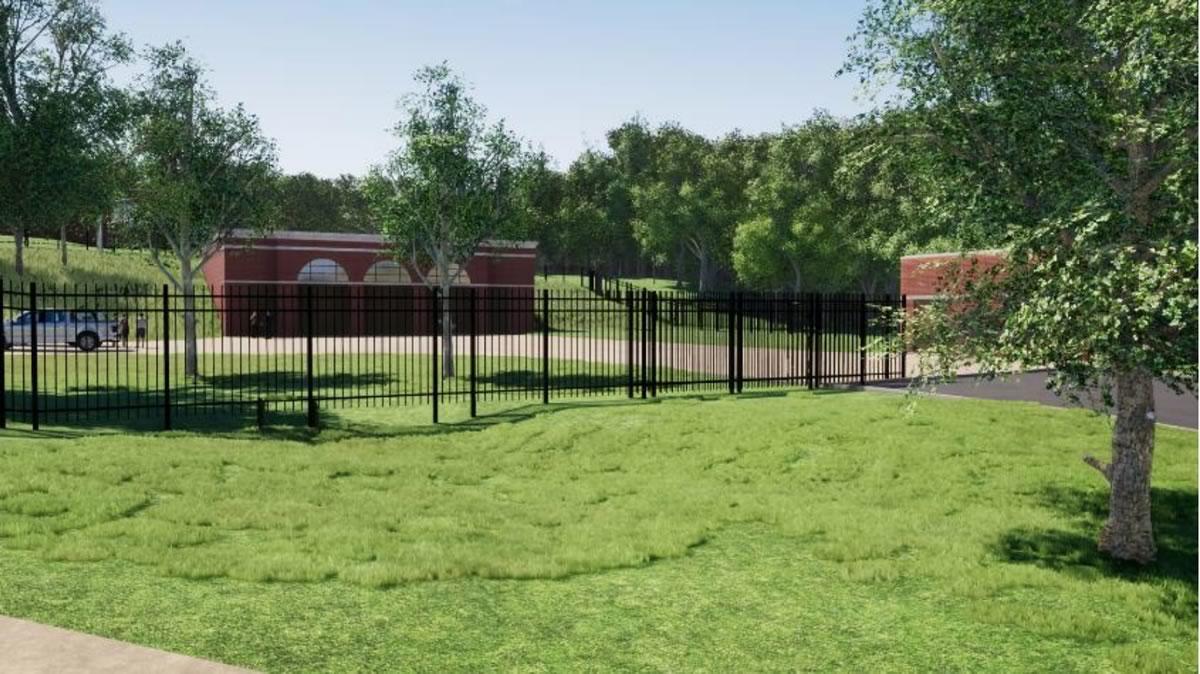
One of the renderings of the project. Much of the facility would be underground.
Albany is an old city, built atop layers of old infrastructure. And it's currently taking on a problem that is literally a hundred years -- or more -- in the making.
Large portions of Albany's (very old) sewer system combine both sewage and stormwater. And when it rains a lot, the system can't handle all that water. So the sewage ends up in the Hudson River. Yep, gross. It's a serious environmental and health problem.
But the city and its neighbors are currently working on a plan to address this problem. And the centerpiece is a $45 million project -- what one official called the biggest public works project in a generation -- that would be located in Lincoln Park.
A sewer facility in a park? People are going to have a lot of questions about that. And they brought them to a public meeting this week.
Here's an overview of the project, along with some of the concerns people have....
There's another public meeting coming up to talk about that new sewer facility planned for Albany's Lincoln Park
The Albany water department has another public meeting set for next Monday, April 23 to talk about the Beaver Creek Clean River Project -- the new sewer facility planned to be built in Lincoln Park in an effort to mitigate the effects of combined sewer overflows on one of Albany's main sewer lines.
Press release blurbage:
The Beaver Creek was once a major watercourse in the City of Albany. The project location is just west of Dr. Martin Luther King Jr. Boulevard at the access road to the Thomas O'Brien Academy of Science and Technology.
The project, led by the City of Albany Department of Water & Water Supply, will address sewer overflows in the ravine to the south of Park Avenue between Delaware Avenue and Dr. Martin Luther King Jr. Boulevard, and includes significant community benefit elements designed to work closely with the education mission of the Thomas O'Brien Academy of Science and Technology.
The project is currently in preliminary design and is scheduled for construction to start in 2019, and be completed and enter operation in 2022. The $45 million satellite treatment project was identified in the 2014 NYSDEC Consent Order. agreed upon by the Albany CSO Pool Communities (Albany, Troy, Cohoes, Watervliet, Rensselaer and Green Island).
The project is the recipient of a $10 million Intermunicipal Grant Award from New York State. The project presentation will solicit input on the proposed design and community benefit proposals.
The meeting is Monday, April 23 at 6:30 pm at the Thomas O'Brien Academy of Science and Technology (TOAST) (94 Delaware Ave).
That long awaited report about the future of 787 is almost ready and there's a chance coming up to learn more and make your voice heard

The formal process for thinking about the future of 787 -- the I-787/Hudson Waterfront Corridor Study -- has been in progress for years. And now it looks like there's a product.
There's a public meeting to discuss the study report March 13 at the Albany Public Library Washington Ave branch. Event blurbage:
Learn about the study findings, progressed and potential strategies, and provide your thoughts on the study's report. This public open house will exhibit informational boards, invite your input on the report, and provide a presentation about the study findings by the project team at 4:30 p.m. and 6:30 p.m. on Tuesday, March 13th. The content of each presentation will be the same.
The open house is from 4-7:30 pm in the auditorium toward the rear of the APL branch.
This report -- headed up by the Capital District Transportation Committee, in collaboration with the state Department of Transportation and the city of Albany -- is the culmination of a process that started in 2014 and has moved slower than originally expected.
Looking ahead on the future of the Helderberg Hudson Rail Trail
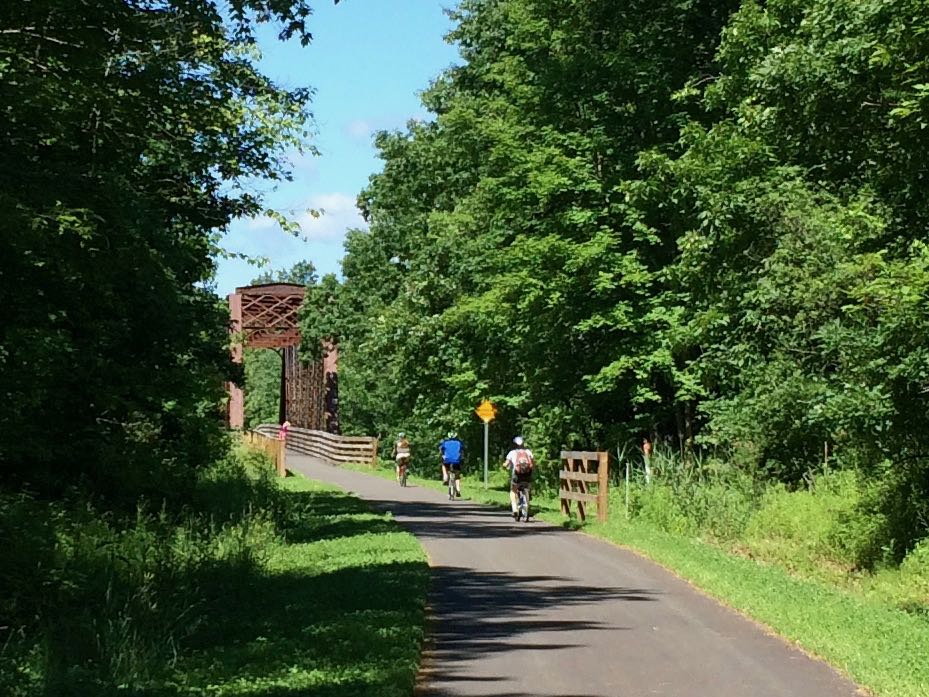
Though a portion of it has only been paved for a few years, the Helderberg-Hudson Rail Trail is already one of the area's most popular hike/bike paths. And 2018 is shaping up to be another big year -- the trail is set for more miles of pavement and a trailhead makeover.
Here are a few things about what's ahead...
Whatever happened to that study about the future of the I-787 corridor?

Back in 2015 there was a series of public meetings to kick off the I-787/Hudson Waterfront Corridor Study, a project intended to help plot the future of 787 from the Port of Albany north to Watervliet. The study got a lot attention because many people saw it as the first step in moving toward knocking the elevated portion of the highway.
Two years later the study is still not out. So what's up?
Moynihan Train Hall construction starting

A cross section of the planned project.
The Cuomo admin announced Thursday that construction is starting on the Moynihan Train Hall, which serve as the new station for Amtrak trains in New York City. The $1.6 billion project is expected to be finished in 2020.
The train hall will be in the Farley Building -- a post office complex -- across the street from Penn Station. Former New York US Senator Daniel Patrick Moynihan proposed the trains-at-Farley idea decades ago, and there was a plan dating back as far as 10 years ago for the construction of a "Moynihan Station" on the site. Now a version of the idea is finally happening.
An underground concourse will connect Moynihan to Penn Station. The train hall will also serve the Long Island Rail Road.
This is of interest here, of course, because NYP is by far the most popular destination from Albany-Rensselaer. And Albany-Rensselaer is one of the nation's 9th busiest train station, with more than 825,000 "on offs" each year. Also: Penn Station is depressing.
Here are new renderings, along with an animated promo video....
From wet land to wetland
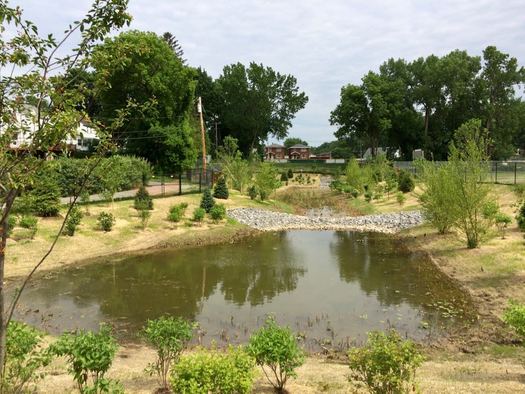
Quick pic follow up on that project the Albany Water Department started last year to build an artificial wetland and underground storage facility for storm water in Woodlawn Park.
The thinking behind the project is that will add some new flexibility to very old sewer infrastructure that runs up the spine of the city along the path of the old Beaver Kill. Areas in neighborhoods along the path have flooded in recently years when a lot of rain has dropped in short amounts of time. This project is intended to act as a buffer for all that water, holding it back from the stormwater system so it can drain gradually without flooding.
The project includes two parts: an "infiltration gallery" -- basically a series of underground tunnels that can hold 750,000 gallons of water -- that's now hidden under the outfield of a baseball diamond there, and a newly-created wetland area with a pond. That second section is now in, and the water department recently added wetland plants.
Here are a few pics of how it turned out...
A "self-sustaining, power-generating island unto itself" in Albany
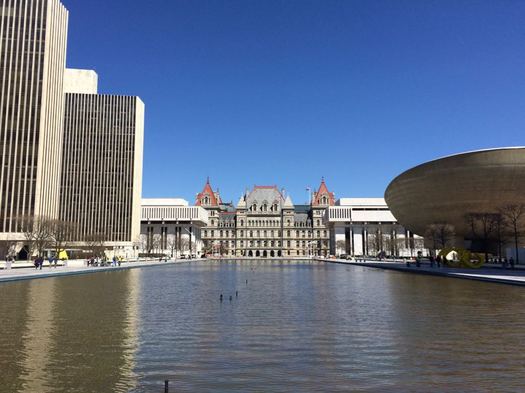
The Empire State Plaza is set to become "a self-sustaining, power-generating island unto itself" as part of a plan formally announced by the Cuomo admin Monday to build a power plant and microgrid for the ESP buildings. In other words, the ESP is basically getting its own power plant and if there's a power outage, it'll still be able to have power.
And that's a good thing. The ESP is the location of many state operations. But the really interesting part of all this might be what this project sets up for other parts of downtown Albany in the future...
A step toward the new 838 area code
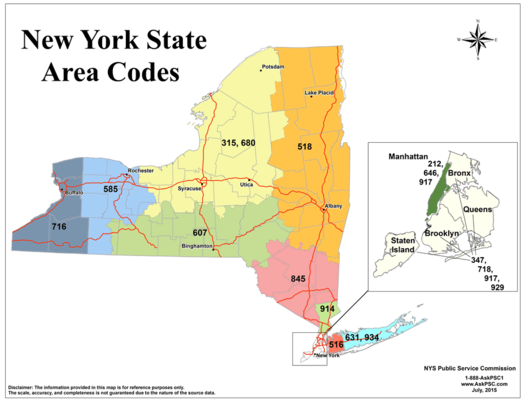
The new area code for this part of New York State is set to start in September. And the first (small) changes for telephone users connected to the new 838 area code begin later this month. From a state Public Service Commission press release blurbage:
As an intermediate step in the implementation of the new area code, a permissive dialing phase begins March 18, 2017, which will allow customers to dial either 7-digits or 10-digits (area code plus 7-digit local telephone number) on calls within the 518 area code; calls to other area codes must still be dialed as 1+ ten digits. The permissive dialing period will end on August 19, 2017, at which time callers will be required to dial 10-digits (area code plus 7-digit local telephone number).
Beginning September 19, 2017, customers in the 518 area code region requesting new service, an additional line, or a move in the location of their service, may be assigned a number in the new 838 area code.
In other words, this is all to get people accustomed to using 10-digit numbers ahead of when they'll actually have to use them.
Oh, and the other way looking at that September date is that it's the deadline for getting a new phone number with a 518 area code -- if, for some reason, that's important to you.
838? What is going on?
Here's the short backstory to all this...
The Empire State Trail
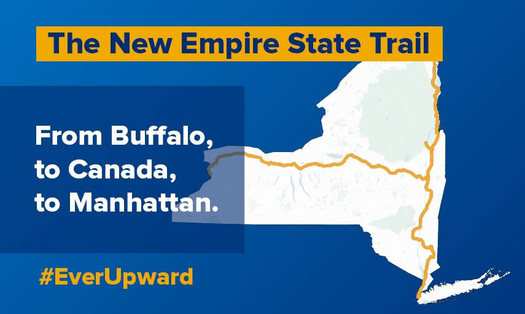
An overview map shared by the Cuomo admin Tuesday.
One of the many proposals to floated during Andrew Cuomo's ongoing State of the State tour this week is a plan to build the Empire State Trail -- a 750-mile multi-use path that would stretch from NYC to the Adirondacks and from Albany to Buffalo.
The Cuomo admin says it'd be the longest state multi-use path in the country.
I-890 from above
If ever you thought you'd like to zone out while watching aerial video of the newly reconfigured I-890 interchange in downtown Schenectady,* the Cuomo administration helpfully provided such video Thursday as part of the official completion announcement of the project.
The clips also include some views of downtown Schenectady and the GE campus.
But, mostly, it's just one shot after another of infrastructure, man.
____
* Not likely, but you never know.
How to store 750,000 gallons of water, out of sight
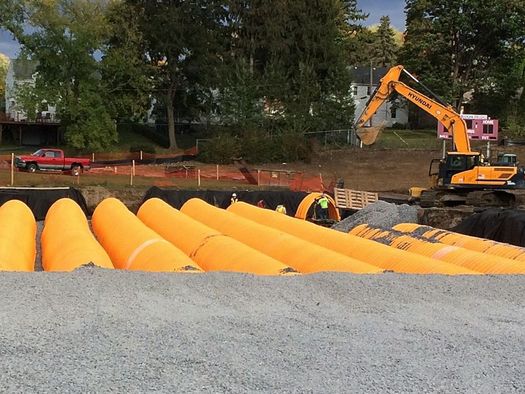
Quick photo follow-up on that big storm water project the Albany water department is building just off Woodlawn Ave, which is aimed at adding some new flexibility to the city's very old sewer spine...
The "infiltration gallery" part of the project is currently going in -- and when it's finished, you won't be able to see it.
This component is basically a series of very large underground pipes that will sit under the outfield of the baseball diamond at Woodlawn Park. They'll be able to hold about 750,000 gallons of water that will either slowly seep into the ground water or be allowed to empty into the sewer at a later time when there's capacity available. The water department will use underground sensors to monitor the capacity of the storm sewer and it'll be able to discharge the water based on the situation.
The infiltration gallery will be paired with a new constructed wetland/pond area right next to it. And the plan is that the $1.9 million project will allow the sewer that runs along the path of the old Beaver Kill/Creek to better handle large rainfall events. In recent years, areas along the sewer line -- such as Elberon Place, and the homes right near this park -- have been flooded with feet of water during very large storms because the storm water system hasn't been able to drain the water fast enough.
Here are a few more pics if you're curious...
The plan for a new NYC train station. (For real this time. Probably.)

Earlier this year Andrew Cuomo floated the latest plan for building a new train station in New York City to replace the outdated and much-unloved Penn Station. The broad outline of the project included the long-planned conversion of the huge post office building across the street from Penn Station.
Now there are more specific details: On Tuesday Andrew Cuomo revealed a timeline for the project, showed more renderings, and said the project will build a "world class" train station.
New flexibility for city's old underground spine

This will eventually be a pond and wetland area.
Back on August 5, 2014, the skies dumped almost three inches of rain on the city of Albany in the span of about an hour.
Parts of the city's storm sewer system just couldn't keep up with the deluge -- and there was flash flooding in many spots. People floating in inner tubes downtown. Spouting manhole covers and more than two feet of water on Elberon Place. And a little farther uptown in a section just off South Main Ave, the backyards and basements of houses were swamped with four feet of water.
Prompted in part by that day, Albany's water department is now building a $1.9 million project aimed at adding some modern flexibility to the very old infrastructure that runs up the city's spine.
Albany area mobile service is toward the back of the pack
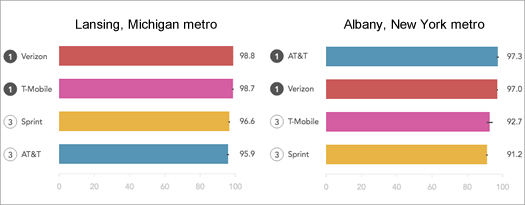
We clipped the RootMetrics overall performance graphs for Lansing (#1) and Albany (#112) and put them side by side.
Maybe it doesn't matter as much if you're toward the back of the pack when the whole group is moving faster.
We were thinking about that while looking through the latest RootMetrics report about mobile service (data and voice) both here in the Albany area and across the nation. Because two things jumped out:
+ The Albany area ranked 112 out of 125 metros for overall mobile network performance. And the Hudson Valley ranked last.
+ But if you compare the individual service provider scores for Albany with that of Lansing, Michigan -- the #1 overall metro -- the difference isn't really that big. (Sprint and T-Mobile service were indicated to be worse here -- and Sprint's data speeds were way slower in Albany.)
Sinkhole swallows SUV in Albany

Laura sent along this pic of the sinkhole at South Lake Ave and Elberon Place in Albany that swallowed an SUV this morning. The spot is just uptown of the western end of Washington Park. (See also: Video clips from the scene by J. P. Lawrence and Kari Beal.)
The Albany Water Department reported that there is a major water main break at the site. From a city press release: "Customers should be aware that they will be experiencing lower water pressure. The Water Department is asking that Albany residents try to conserve water until repairs are made."
A handful of history-minded people were noting this morning that the sink hole is in the path of the Beaverkill, one of the major streams that once flowed through the city. It was buried underground decades ago as development stretched to the west.
Update: After the jump there's an embedded video showing the scene from above -- it shows the scale of the hole with the SUV in it and the water main gushing water.
Thinking about Capital Region commuter rail

A Shore Line East commuter rail service train in Connecticut. / photo: Pi.1415926535 on Wikipedia (CC BY-SA 3.0)
The topic of bringing rail transit to the Capital District is one that comes up regularly every few years. Certainly, there are a good number of well-intentioned advocates out there in the region who believe that to have a serious transit option, the Capital District must have rail.
I don't -- at least, not yet. And here's why.
Goodbye, Time Warner Cable
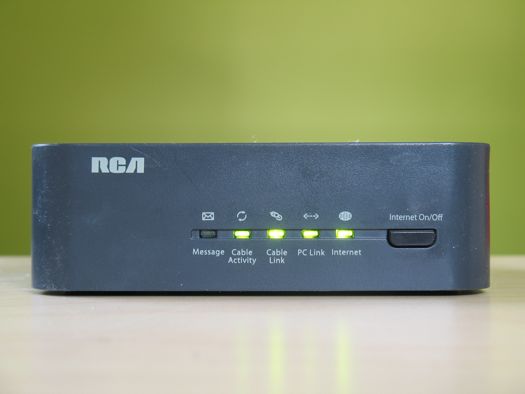
Time Warner Cable is now officially part of Charter Communications after the $55 billion acquisition closed today. And that means the TWC brand will be fading away. The combined company will be called Charter, and the services -- such as cable TV and internet access -- will be marketed under Charter's Spectrum brand. [Bloomberg]
So, if you're a TWC customer, what's all this mean?
Well, Charter's CEO said today in a press release that there won't be many changes right away, but there will eventually be "product improvements and consumer friendly policies."
Here are a few things to keep an eye on:
Designing for safer Capital Region streets
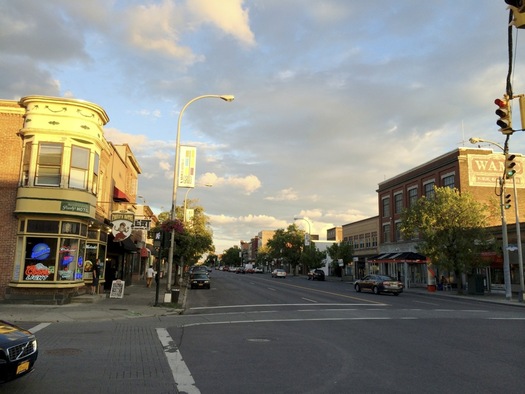
Central Ave at Quail Street in Albany.
Street safety has been a major topic of discussion in the Capital Region recently, from Albany's red light cameras to the Madison Avenue road diet to the death of a young boy in Albany and far too many others across the region. It's pretty clear that everyone agrees something must be done.
To a large extent, though, it seems that the discussion about road safety for all users has focused on more and better enforcement of existing laws as a solution to the toll. And while enforcement of speed limits and road safety -- which, in my experience, is pretty nonexistent in much of the region -- is absolutely part of the ultimate fix, the focus on it ignores that there is, in fact, a much more effective solution at hand: better design of our streets and roads.
Here are a few examples:
What if tearing down I-787 could actually improve traffic?

The future of I-787 often pops up in conversations about downtown Albany - specifically, the desire that many people apparently have to see the elevated highway torn down.
There's a currently a longterm effort by a group of state and local agencies to study this overall topic. And you're probably already familiar with some of the potential benefits the tear-it-down crowd touts: A boulevard replacement would reconnect the city with the waterfront. It could improve air quality, especially in some underprivileged areas. And it could open up considerable portions of land for development.
Of course, one of the counter arguments is that 787 is necessary to handle the large amounts of traffic that flow into Albany each weekday, and tearing it down would tip downtown into traffic gridlock.
But what if it was just the opposite -- what if tearing down 787 could actually make traffic in Albany flow more smoothly and efficiently?
Revisiting the reservoir goats

A month ago the Albany Water Board announced it had hired (so to speak) five goats to clear a brush-covered section of the land around the city of Albany's Loudonville Reservoir.
A strip along the eastern edge of the reservoir had become choked with a tangle of trees, bushes, and vines -- and the slope of the land made it hard to work on, especially since debris would have to be kept out of the reservoir. Apparently it was difficult enough that the water board had trouble finding a contractor willing to take on the tricky task.
Enter the five goats from Heather Ridge Farm as a sort of test of the concept of goatscaping.
So, how'd that turn out?
Reservoir goats
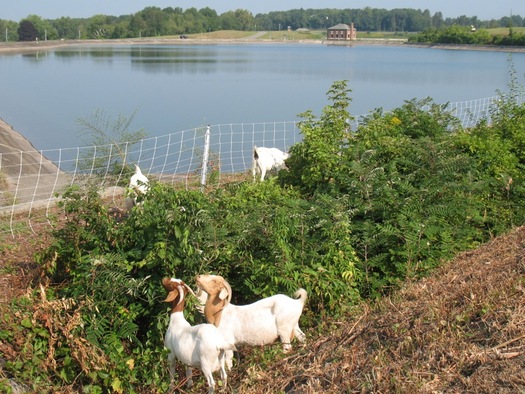
They're working.
It can be hard to hire a contractor. Sorting through all the various options. Coordinating calls and appointments for estimates. Trying to pick the best person.
And what if, as the Albany Water Board recently decided, the best person for the job is... a goat?
Four takeaways from the kickoff for the study about the future of I-787

A large map was laid out so members of the public could annotate with ideas.
The planning project for the future of I-787 -- and the waterfront -- got off to its public start Wednesday with presentations at the Albany Public Library.
The I-787/Hudson Waterfront Corridor Study is sponsored by Capital District Transportation Committee, the state Department of Transportation, and the city of Albany. Its focus extends from the Port of Albany along the riverfront north to Watervliet. And its aims include helping develop strategies for improving waterfront access and guiding future transportation planning.
We stopped by for the early presentation (the same presentation was to be repeated in the evening), and took some time to check out the various posters and other "visioning" materials.
Here are four impressions/takeaways...
Planning for how we'll all get around the Capital Region in the future

If our future overlords will be self-driving vehicles, it's probably a good idea to have a plan fo them. (If only so we can properly welcome them.) / photo: Google
A bit of follow-up to that discussion about trends that are shaping the way people get around the Capital Region: The Capital District Transportation Committee has a couple of public meetings this week to go over the draft version of its New Visions 2040 Plan -- this is the map (of sorts) for thinking and planning all sorts of regional transportation stuff, including roads, bridges, traffic congestion, CDTA, bike lanes, car sharing, road diets, even stuff like self-driving cars.
The meetings are:
+ Tuesday, June 16 at the Empire State Plaza (Meeting Room 6, Concourse Level) from 6:30-8:30 pm
+ Thursday, June 18 at Niskayuna Town Hall from 6:30-8:30 pm
The full draft plan is online if you'd like to have a look (there's also an executive summary and listing of key recommendations.) If you're curious about any of the topics mentioned above, you'll probably find at least a few interesting bits.
After a quick read through, here are a handful of things that caught our eye:
Workshops on the future of I-787
The planning project for the future of I-787 -- and the waterfront -- has a pair of public workshops lined up for later this month. As the flyer for the events says: "Help Us Visualize the Future of the Corridor."
Expanded blurbage:
Join us at one of two public workshops on June 24th in Albany or June 30th in Watervliet to discuss the future of the I-787/waterfront corridor. The purpose of the workshops is to introduce the study and its objectives, to share information on existing land uses and the transportation system and to provide opportunities for input on short and long term transportation and land use strategies.
Along with a brief presentation, workshop attendees will be able to view study area maps and data, can offer initial input on strategy and evaluation criteria and can participate in a hands on "map your ideas" station.
The first workshop is June 24 at the Albany Public Library main branch on Washington Ave from 4-7:30 pm (with presentations at 4:30 pm and 6:30 pm).
The second workshop is June 30 at the Watervliet Senior Citizen Center (1541 Broadway) from 5-7:30 pm (presentation at 5:30 pm).
The I-787/Hudson Waterfront Corridor Study is sponsored by Capital District Transportation Committee, the state Department of Transportation, and the city of Albany. Its focus extends from the Port of Albany along the riverfront north to Watervliet. And its aims include helping develop strategies for improving waterfront access and guiding future transportation planning.
Whenever we ask people here at AOA about things they'd like to see changed about area, 787 gets mentioned. A lot. So this could be a good opportunity to get your concerns and ideas on the record with planners.
Furthermore: A lot of cities have been facing the issue of what to do with their urban (often elevated or waterfront) highways. Just down the Thruway, Syracuse has been trying to sort out what to do with I-81, an elevated highway that runs right through the middle of downtown, a process that's included conflict between the city and its suburbs. (Here's the latest on the I-81 storyline.)
As part of the planning process for the next I-81, the Syracuse Metropolitan Transportation Council put together a bunch of case studies about how other cities have handled remaking urban highways -- it's worth a look if you're interested in the topic.
Cast iron and hollowed-out tree trunks
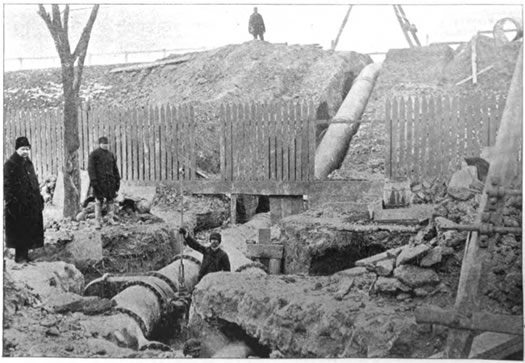
A water main being constructed at the former Bleecker Reservoir in Albany around 1898. (The reservoir would later be converted to Bleecker Stadium.)
Reading this recent NPR segment -- about the 200- or 300-year replacement cycles for water mains in some cities -- got us curious about Albany's water mains. And that led us to this bit from the Albany water department (emphasis added):
Fifty-five miles of Albany's 376 miles of water mains were installed in the mid-19th Century. However, some of the mains may even be older, with some cast iron mains possibly installed in 1813. If true, Albany would have the oldest functioning cast iron pipe in the western hemisphere. Incidentally, all of the water mains in the City originally were hollowed-out tree trunks, many installed in the 1700's. Although unlikely, there is a very remote outside chance that somewhere beneath some of the oldest parts of our City, a functioning wooden water main remains.
Yep, hollowed-out tree trunks (see: a 19th century overview of how that worked). And about 15 percent of Albany's water mains are at least 150 years old.
That a good chunk of the city's water infrastructure stretches back a century-and-a-half makes sense. It was around 1850 that the city started the planning on what would be the foundation of its modern water system.
How New York State generates electricity

That air conditioner compressor isn't going to spin itself.
The biggest source of carbon dioxide emissions in the United States -- almost 40 percent -- is electricity generation. So the Obama administration's announcement this week that the EPA is proposing new emission targets for states in order to reduce CO2 emissions from power plants by 30 percent by 2030 is a big deal.
New York State is line for one of the largest percentage cuts in the nation: a 44 percent decrease in the amount of CO2 emitted by Empire State power plants per megawatt hour of electricity produced. As it happens, New York is is line for such a big cut because it's already moving in that direction, thanks in part to its participation in the Regional Greenhouse Gas Initiative here in the Northeast and the fact that it doesn't rely much on coal for generating power. If New York hits its target, it would be among the states with the smallest carbon emissions per unit of electricity produced. (The EPA rule gives states some flexibility on how to meet their goals.)
Anyway, the news got us interested in how New York State generates electricity -- what are the sources, what are the trends in those sources, the biggest power plants.
So we pulled together some numbers, and here are five charts about the topic (along with a map... because maps).
The Atlantic: The future of urban highways is playing out in upstate New York
 Over at The Atlantic Cities today there's a good overview of the situation surrounding the impending replacement of I-81 in Syracuse, which runs right through the heart of the Salt City's downtown. The situation will probably sound very familiar to anyone who's thought about the future of I-787 in Albany. A clip:
Over at The Atlantic Cities today there's a good overview of the situation surrounding the impending replacement of I-81 in Syracuse, which runs right through the heart of the Salt City's downtown. The situation will probably sound very familiar to anyone who's thought about the future of I-787 in Albany. A clip:
City leaders like Robinson, along with downtown developers and advocates for smart growth, would like to see I-81 rerouted around Syracuse and replaced with a landscaped boulevard. But suburban business-owners and many of the 45,000 drivers who use the highway to commute fear that any change could hurt the local economy. It's a debate that goes beyond the immediate question of how Syracuse workers will get to work -- to what kind of city Syracuse will be in the 21st century.
Similar discussions are happening across the United States, says John Norquist, president of the Chicago-based Congress for the New Urbanism, which publishes an occasional list of interstates ripe for demolition. Many urban freeways -- a staple of mid-20th century car-centric development -- are beginning to fall apart, and today cities from New Haven to Seattle (not to mention others around the world) are taking the dramatic step of tearing them down. A former Milwaukee mayor, Norquist oversaw the conversion of an elevated highway to a boulevard there in 2002, following a model pioneered by Portland in 1978 and San Francisco in 1991.
"It's starting to happen all over the place, and there's a reason for it," says Norquist. "Freeways don't add value to cities. They're all about one dimension, which is just moving traffic. It's a rural form, visited upon the city, that destroys property values, commerce and vitality."
The article, by Amy Crawford, is a good overview because it captures many of the tensions of the situation -- between city and suburbs, between walkable and automobile infrastructure, between local and state decision making. And, oh yeah, cost.
As that clip mention, the thing about these elevated highways, 787 included, is that they eventually will reach the end of their lives -- because they will be literally falling apart. That will mean hard choices -- and maybe also big opportunities.
[via @rachbarnhart]
Earlier:
+ In another upstate city, a discussion about an urban highway
+ "The Life and Death of Urban Highways"
+ The Albany 2030 plan included a goal of evaluating possible alternative designs for 787
+ The Stakeholders org released a report in 2011 that imagines the Albany waterfront with a boulevard
map: I-81 Challenge
A quick scan of Joe Biden's appearance at the state Capitol

Vice President Joe Biden dropped into Albany today for an appearance at the state Capitol, to talk about rebuilding infrastructure after the storms that have hit the state in recent years, to literally and figuratively give Andrew Cuomo a pat on the back -- and see a Cuomo powerpoint presentation. "I wish everyone could see this presentation," Biden said (really, he actually said that).
Infrastructure is an important issue, but it's one of those topics that tends to make people start to glaze over a bit -- you know, until it breaks. So it's worth paying attention to it, maybe even better if someone else watched it for you. As we did.
Here's a quick-scan recap of Biden's appearance at the Capitol Tuesday...
In another upstate city, a discussion about an urban highway
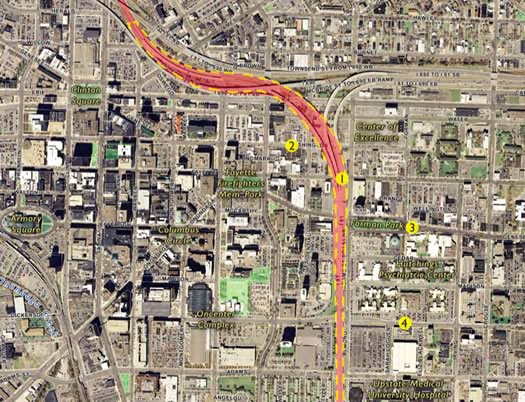
Syracuse's I-81 viaduct.
Related to the I-787 discussion that pops up now and then: There's an interesting situation in Syracuse regarding what to do with the the elevated portion of I-81 that cuts right through the middle of that city. The thoroughfare is falling apart, so something has to be done -- and the options have been narrowed down to either: turn the stretch into a six-lane boulevard through the city, or completely rebuild the elevated highway. [I-81 Challenge] [Syracuse Post-Standard]
Some of the numbers involved in the decision are eye-popping: both the boulevard and reconstruction of the 1.4 mile stretch could cost as much as $900 million, according to the Syracuse Post-Standard article linked above. Other options -- such as burying the road -- have been dismissed because they'd cost in the $1.5 billion range.
The situation in Syracuse has ended up polarizing along city/suburb poles, with the county legislature and developers opposing the boulevard because of concern it would make it harder for suburban commuters to get in and out of the city. In a recent op/ed, David Rubin -- a former dean at Syracuse University, which sits right along I-81 -- called the project "the most important civic decision of the past 60 years or more" and argued for the boulevard plan. [Syracuse Post-Standard] [Syracuse Post-Standard]
Case studies: The state Department of Transportation and the Syracuse Metropolitan Transportation Council have collaborated on an ongoing public discussion about the project called "The I-81 Challenge." It produced a report that includes a bunch of case studies of how other cities have dealt with the reconstruction or reconfiguration of urban freeways. If you're interested in the future of 787, the case studies are interesting reading.
Earlier:
+ "The Life and Death of Urban Highways"
+ The Albany 2030 plan included a goal of evaluating possible alternative designs for 787
+ The Stakeholders org released a report in 2011 that imagines the Albany waterfront with a boulevard
+ The removal of 787 in downtown Albany was on Martin's urban wish list
map: I-81 Challenge
Proctors theater... and power plant, trash collection, and internet service
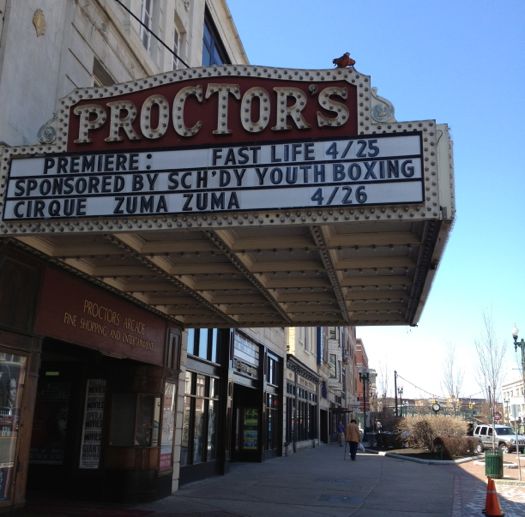
An old Vaudeville theater that hosts Broadway road shows like Wicked and Book of Mormon, plus films, comedy, and music is easy to write about. There's glitz, there's glamour, there's history. It's sexy.
A district energy plant that heats and cools businesses along a city block -- less sexy.
OK, but what if the same place also collects trash? And sells internet and phone service? And hosts Broadway touring companies, films, comedy and music performances.
Then it's Proctors.
When you pass by the Schenectady theater and arts hub, here are a few interesting things that you won't see on the surface.
Video of downtown Albany underground explosion
Boom goes the manhole.
Here's a video clip via the Albany County Sheriff's Office of the underground explosion in downtown Albany Wednesday afternoon. The explosion knocked the cover off a manhole and shot flames into the air.
The camera that captured the explosion is pointed down Steuben Street toward the intersection of Steuben and Chapel. You can see dark gray smoke first billow from the street, then BOOM! (Actually, you have to supply your own soundtrack -- there's no audio.)
There are a few stills from the video after the jump.
National Grid says the explosion was caused by an underground fire on an electrical wire. It says no one was hurt. The company is investigating what caused the fire.
Reports: underground fire, blown manhole covers in downtown Albany
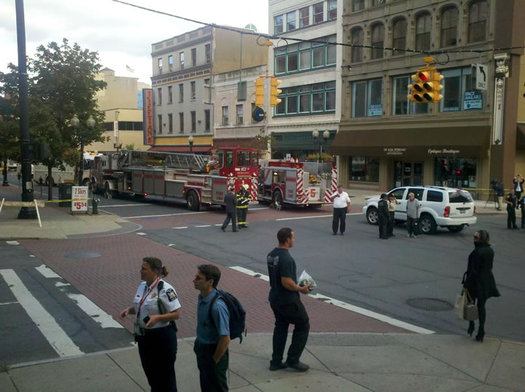
Update: Here's video of the explosion.
____
Around 3:30 pm Wednesday afternoon, mentions of an underground fire in downtown Albany -- with exploding manhole covers -- started popping up on Twitter. Albany County exec Dan McCoy posted on Twitter at 3:53 pm: "Fire in electrical network underground. Manhole covers blew. Work underway." [@DanielleSanzone] [@MCCoyCountyExec]
The Albany County Justice Center was evacuated because smoke was drawn into the ventilation system. Albany City Hall was closed. And there were reports of other buildings being closed. [Albany County] [@LeifEngstrom1 (city auditor)] [@jessicabakeman]
Streets near the county justice center were closed for crews to work on the problem. [@MCCoyCountyExec]
The photo above -- at North Pearl and Pine -- is from Andrew Gregory (@lunchboxbrain).
Update: 8:44 pm: From National Grid spokesman Patrick Stella:
At 3 p.m. today we detected a power interruption on an underground line at North Pearl Street in Albany. We immediately dispatched crews who have been working through the evening to assess and repair damage caused by an underground fire on our electrical wire.
One manhole cover was dislodged due to the fire and no injuries were reported.
There were no outages associated with the fire since the downtown area has multiple electric feeds to each customer.
We expect to make those repairs tonight and have the street open for traffic.
We will investigate the incident in an attempt to determine an extact cause.
This sounds familiar...: Something like this happened in downtown Albany in 2009.
A heads up when something could stink about the Hudson River
 Passed during the end-of-session rush at the Capitol: the "Sewage Pollution Right to Know Act." The environmental org Riverkeeper explains:
Passed during the end-of-session rush at the Capitol: the "Sewage Pollution Right to Know Act." The environmental org Riverkeeper explains:
The Sewage Pollution Right to Know Act, once signed by the Gov. Andrew Cuomo will make public reporting about unsafe water conditions nearly as routine as severe weather warnings. The law will require public wastewater treatment plants to publicly disclose within four hours of releasing raw or partially-treated sewage. The state will also for the first time report annually on reported sewage discharges.
This is an important issue around here because of something called "combined sewer overflows" (CSOs). Basically, when many of the antiquated sewer systems in this area become overwhelmed with storm water, they start dumping the excess -- sewage and all -- into the Hudson and its tributaries. Yep, eww.
Riverkeeper did testing last year for sewage-indicating bacteria in Hudson -- and two of the worst spots for contamination were near Albany (Island Creek/Normans Kill in Glenmont, and the Dunn Memorial Bridge). The org reported that the Capital Region's CSOs "dump an estimated 1.2 billion gallons of combined sewage and wastewater into the Hudson each year."
[via @AndyArthur]
Earlier on AOA: Something stinks about the Hudson near Albany (includes some good discussion in the comments)
photo: Flickr user andyarthur (cc)
"The Life and Death of Urban Highways"
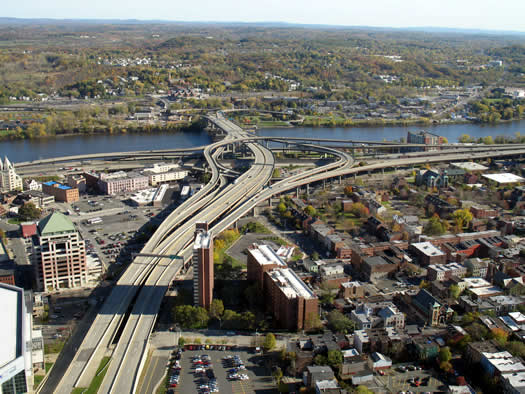
Another log for the "tear down 787" fire: The Life and Death of Urban Highways, a survey of why cities around the world have been tearing down urban highways -- and what has happened when they've done so. (Update: That link wasn't working for some reason Tuesday evening, so the report is now embedded after the jump.)
Among the reasons cited by the report that urban highways have fallen out of favor:
+ Costs of reconstruction and repair: Cities are finding out how much it costs to maintain these highways and are deciding the money is better spent other ways.
+ Economic revitalization: Removing the highways, which serve as dividers in the urban landscape, has opened the way for new development of neighborhoods -- and in many cases, higher property values.
+ Making accessible waterfronts: Many urban highways -- like 787 -- parallel waterfronts, and removing them reconnects the waterfronts to the city, again opening the way for parks, development, and higher property values.
The report also includes case studies from cities such as Portland, Oregon, San Francisco, and Milwaukee.
The orgs responsible for the report, Institute for Transportation and Development Policy and EMBARQ, advocacy orgs that both appear to be very much of the Jane Jacobs, pro-public transit school -- just something to keep in mind while reading through the report so grains of salt. It's interesting reading, and it's easy to see how many of the issues brought up could apply to the Capital Region.
The thing to keep in mind about 787 is that there's no "do nothing" option over the long run. If it stays, it has to be maintained -- and that's not cheap. If it goes... that's not cheap, either. So, the question really is: if we (the region/state) are going to spend (tens, hundreds of) millions on this key piece of infrastructure, what do we ultimately want to end up with? And is it worth it to us to spend more upfront to have something possibly better (though not necessarily guaranteed) in the future?
[via @SeanPCollins via Grist]
Earlier:
+ The removal of 787 in downtown Albany was on Martin's urban wish list
+ The Albany 2030 plan included a goal of evaluating possible alternative designs for 787
+ The Stakeholders org released a report last year that imagines the Albany waterfront with a boulevard (it's also embedded after the jump)
+ Syracuse has been considering the removal of the elevated portion of I-81 that runs right through the heart of the city [Streetsblog]
The NanoBridge over Washington Ave Ext
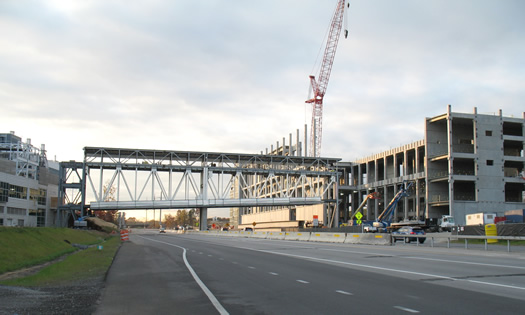
We'd say the bridge changes the character of that stretch, but it didn't have a lot of character to begin with.
Washington Ave Extension was closed this past weekend for the construction of a bridge connecting Albany NanoTech to its new building, the "NanoFab Xtension," across the road. For the infrastructure enthusiast, a few more large format photos are after the jump.
The Washington Ave Ext/Fuller Road re-alignment project will move Washington to the north so that it routes around UAlbany's College of Nanoscale Science and Engineering campus. The bridge will then span a parking lot for the college.
Seeing the bridge spanning the two buildings made us think back to a joke NanoEmperor Alain Kaloyeros made a few years back in Businessweek about expanding the campus so that he could walk to the Starbucks at Stuyvesant Plaza without going outside. What's a few more bridges...
Earlier on AOA: NANOvember
Section of Washington Ave Ext to close Nov 5-6
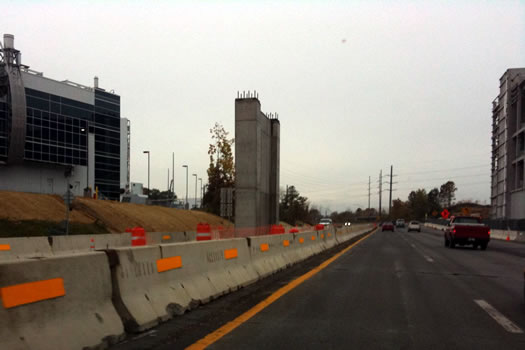
For a bridge?
Update: Albany police say Washington Ave Ext will closed from 10 pm Friday (November 4) to 6 am Monday (November 7).
Washington Ave Extension will be closed from Fuller Road to the Crossgates Mall entrance November 5-6 (a Saturday and Sunday), according to an electronic sign posted along the road (map). The mall entrance off Washington Ave Ext will remain open those days.
We have heard, unofficially, that the road will be closed for the construction of the bridge connecting the new Albany NanoTech building with the existing building to the south of the road. There's already what looks like a support standing in the road's median, and there are pre-assembled structures for what looks like a bridge sitting behind Albany NanoTech. (We have a call in to confirm this. If we hear back, we'll update.)
It looks like the new NanoTech building is coming along quickly. Its structure now stands tall against Washington, and forms a sort of short corridor with the other College of Nanoscale Science and Engineering building. Washington Ave will eventually be moved north of the new building as part of the Washington/Fuller re-alignment, opening more space for Albany NanoTech.
The new building will house facilities that are part of the $4.4 billion chip-manufacturing research project the state recently announced. It will also reportedly provide space for a solar energy research consortium.
Earlier on AOA: What's up at Washington and Fuller?
A walkable Livingston Avenue Bridge
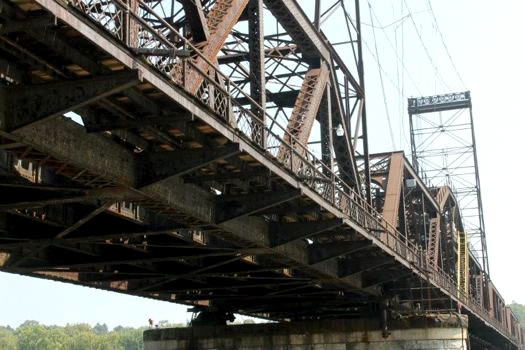
A way across the Hudson -- possibly for more than just trains.
 It's a frustrating thing to watch bureaucracy get in the way of great vision. It can result in some pretty bad decisions, the kind that make you look back and say "woulda, coulda, shoulda..." when it's too late to make changes. Which is what we may be saying soon about the pedestrian walkway on the Livingston Avenue Bridge.
It's a frustrating thing to watch bureaucracy get in the way of great vision. It can result in some pretty bad decisions, the kind that make you look back and say "woulda, coulda, shoulda..." when it's too late to make changes. Which is what we may be saying soon about the pedestrian walkway on the Livingston Avenue Bridge.
The bridge has become a very important issue to many cycling advocates and pedestrians. I am one of them. I tell people this is my "chickens issue" -- a project that could significantly transform Albany.
So what's so special about a walkway on a bridge?
What's up at Washington and Fuller?
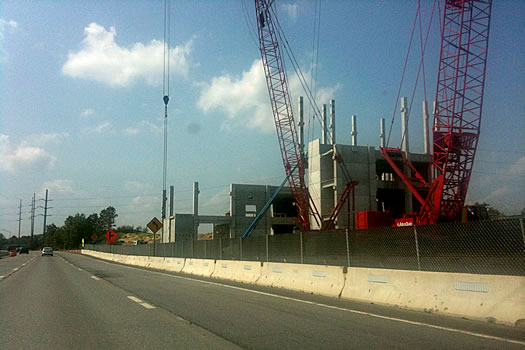
The nano empire expands.
You've probably noticed there's a lot going on at the super busy intersection of Fuller Road and Washington Ave in Albany. What with the hill that's now gone, and the large structure rising in its place, it's hard to miss -- whether you're driving along Washington, Fuller or the stretch of I-90 along there.
Here's what's up...
Something stinks about the Hudson near Albany
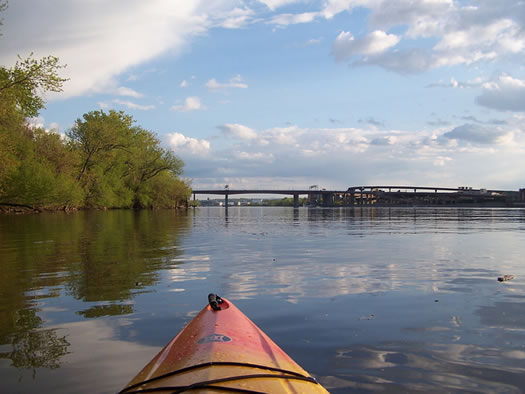
The Hudson River at the Dunn Memorial Bridge was among the 10 worst spots in the study.
The environmental org Riverkeeper released a report this week on Hudson River sewage contamination levels -- and the results for this part of the Hudson were... uh... gross.
Riverkeeper's testing found sewage-indicating bacteria levels were above acceptable limits more than 50 percent of the time at both Island Creek/Normans Kill in Glenmont (65 percent of the time) and the Dunn Memorial Bridge in Albany (50 percent). Those two spots were among the top-10 worst of all the spots tested. The data for all the locations tested are posted online -- and table with local data is after the jump.
So, what's causing this problem? The Capital District's combined sewer systems dump untreated sewage into the river when they're over capacity (example: after a heavy rain).
Riverkeeper says the systems release 1.2 billion gallons of untreated sewage and wastewater into the river each year.
What are those holes by the ESP?
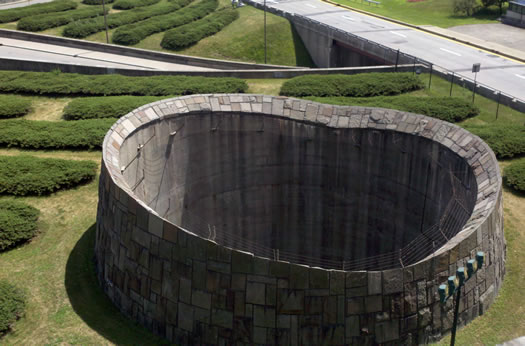
Helloooo?
Joe emails (with the above photo):
Re: The Mystery Hole at Empire State Plaza
I figured you guys might know - I can't even speculate as to what the hell this structure is and its always puzzled me. The view is looking east over the side of ESP near the egg. Why are the walls so high? What in the blue blazes is this thing??
We've wondered about those holes, too. (You can see them very clearly in satellite photos.) And we had some guesses.
But to get the word straight from the source, we contacted the New York State Office of General Services, which runs the ESP.
South Mall Expressway closed
The state Department of Transportation announced Wednesday night that it was immediately closing the South Mall Expressway -- that's Routes 9 and 20 between the Empire State Plaza and the Dunn Memorial Bridge -- because an inspection found cracks in beams that support the road. The full release -- with suggested alternate routes -- is after the jump.
Also part of the closure: the Madison Avenue off-ramp from I-787 south, the South Pearl Street on-ramp leading to the Dunn Memorial Bridge, and the part of Broadway between the Quay Street Connector and Madison Avenue.
The Dunn is still open, but down to one westbound lane (that is, heading toward Albany). Albany police say they expect backups Thursday morning, maybe as far back as Rensselaer. They're suggesting people use alternate routes if possible.
Everywhere the hum of air conditioners

Vrvrvrvrvrvrvrvrvrvrvrvr...
New Yorkers set a record for single month electricity usage in July, according to NYISO -- the org that manages most of the power grid in the state.
Total usage was at 17,312 gigawatt-hours (yeah, sounds big). It tops the old record, set in August 2005, by about two percent. And it's up 19 percent from last July.
The state also almost set a new record peak demand on July 6.
This past July in the Capital Region was hot -- but not extraordinarily so. The average temp was 74.9, which doesn't even rank in the top 10 (we needed to hit 76.5 to crack that list). There were eight days over 90 -- about four more than usual.
New York City was smokin', though. Its July was the second hottest month on record there.
Block by block, Washington Place is back together
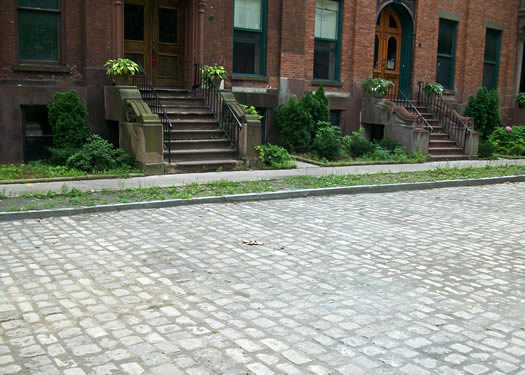
The new/old street -- level again.
How do you rebuild a street? In the case of Troy's Washington Place, the answer is: one stone at a time.
The street -- which runs along the picturesque (and private) Washington Park in Troy -- is made up of Belgian block pavers (sort of like cobblestones, but square and a regular size), that were first laid during the 1800s. About 35,000 pavers. And reconstruction of the road required every one of the pavers to be removed and then re-installed -- by hand, like installing a giant patio.
When the street got to be in such bad shape that it was nearly impassable (undulating would have been a kind word), the Washington Park Association rallied support to preserve the pavers -- and the historic look of the streetscape. Now the association reports the job is finished. The official ribbon cutting will be August 3.
WPA reports that the job cost $200k, and a handful of organization contributed services -- including the City of Albany, which donated 8,000 pavers to replace blocks that had broken.
Here's a photoset covering the reconstruction project.
photo courtesy of TAP, Inc via Duncan Crary Communications
Wink: high-speed wireless for Albany
 If you've tried to use wireless internet on Lark Street or other parts of downtown Albany, you've probably tried, or at least seen, Albany FreeNet. Tech Valley Communications offers the free wireless service in Albany's downtown business corridors.
If you've tried to use wireless internet on Lark Street or other parts of downtown Albany, you've probably tried, or at least seen, Albany FreeNet. Tech Valley Communications offers the free wireless service in Albany's downtown business corridors.
Today Tech Valley Com rolled out a premium wireless internet service in Albany. It's called Wink.
We talked with Tech Valley Com's wireless director, Jeff Mirel about Wink, Albany FreeNet and the dream of a free-wireless city.
The Troygle video
Here's the video produced by Troygle, the collaborative effort to land the Google community fiber test:
Also: a trio of cute experts weigh in on Troy's bid.
Earlier on AOA:
+ Troygle's need for speed
+ Wooing the Google
+ Ooh, Google, over here! Over here!
Troygle's need for speed
 Troygle, the collaborative effort to land Google's community fiber project, has a rally/press conference/video shoot lined up for Monument Square tomorrow:
Troygle, the collaborative effort to land Google's community fiber project, has a rally/press conference/video shoot lined up for Monument Square tomorrow:
This is a good date/time for the City of Troy, for the Hellions and hopefully for you... We need everyone there ready to wave, cheer, feel lucky, and bring Google to Troy! Our community participation and enthusiasm means everything to this process.
...
THE NEED FOR SPEED - Be there, or be twentieth century!
The Hellions of Troy and (a hoped-for) 100 Uncles Sam will be there, so how could Google resist. The event starts at 5 pm.
While everyone's there: The odds of winning this Google project are long. Maybe Troygle can help prompt discussion about how to bring better, cheaper bandwidth to more people in Troy and Capital Region -- with or without Google.
Earlier on AOA:
+ Wooing the Google
+ Ooh, Google, over here! Over here!
Wooing the Google
 The collaborative effort to pitch Troy for Google's community fiber project is pushing ahead. The effort now has a site: Troygle. And the city government has gotten involved with the planning process. [Troy Record] (There's been a Facebook page for a few weeks.)
The collaborative effort to pitch Troy for Google's community fiber project is pushing ahead. The effort now has a site: Troygle. And the city government has gotten involved with the planning process. [Troy Record] (There's been a Facebook page for a few weeks.)
The best quick argument we've seen for Troy's bid came from Lou in a comment:
1. Because of RPI, Troy has a sizable population of folks who'll come up with clever ways to weave all that bandwidth into their daily lives, and who'll have the skills to report on the effects in detail.
2. Because there's a sizable underprivileged population, Troy's a good lab for examining the public benefits of superior data infrastructure.
3. Troy's big enough, but not too big. Significant yet economical.
Saratoga County is apparently also looking to make a pitch. [Post-Star]
As you might imagine, the competition to win this project is fierce. Towns are using basketball crowds, flash mobs and mayors with shrinkage to attract attention. Topeka, Kansas even temporarily re-named itself... Google.
[FastCompany link via @dougbartow]
Ooh, Google, over here! Over here!
 No doubt as part of some plot to index the contents of our brains, Google is planning to test ultra-highspeed fiber networks in communities around the country (ok, maybe they don't want to index our brains... yet). From the Google project page:
No doubt as part of some plot to index the contents of our brains, Google is planning to test ultra-highspeed fiber networks in communities around the country (ok, maybe they don't want to index our brains... yet). From the Google project page:
We plan to test ultra-high speed broadband networks in one or more trial locations across the country. Our networks will deliver Internet speeds more than 100 times faster than what most Americans have access to today over 1 gigabit per second, fiber-to-the-home connections. We'll offer service at a competitive price to at least 50,000 and potentially up to 500,000 people.
A gigabit per second? Yes, please. That's like going from a spigot to a fire hose. (Road Runner is 1.5 megabits per second -- there are 1024 megabits in a gigabit.)
So, we know one or two communities that could use something like that.
As @EdXeno tweeted yesterday to Harry Tutunjian: "I would leave Albany and move to Troy if you got Google to give you awesome internet access."
Jeff Pirro, a spokesman for the Troy mayor, tweeted back today: "A lot of folks like yourself have given us and heads up and at the Mayor's direction, we're looking into it."
Obviously there's going to tremendous competition for this project. But, hey, you never know. It's worth a shot.
Google is asking municipalities to "provide us with information about their communities through a Request for information (RFI), which we'll use to determine where to build our network." It's also taking community "nominations" from residents and community groups.
Update: There's now a Facebook page to organize support for Troy's bid. (Thanks, Kim M!)
... said KGB about Drawing: What's something that brought you joy this year?